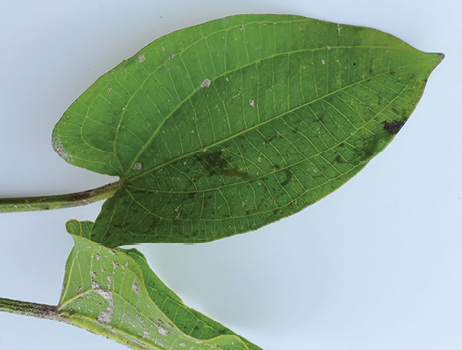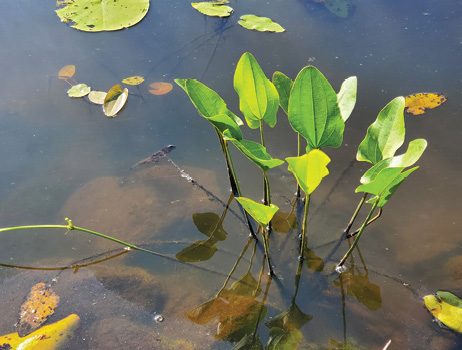Creeping Burhead | Echinodorus cordifolius
Emergent | Native



float in shallow water.
A mixed stand of plants including creeping burhead float in shallow water.
Native to the eastern United States, creeping burhead is an annual or short-lived perennial species that is in the same family as arrowhead (Sagittaria) and may be confused with that genus. Creeping burhead can grow as high as 4 feet and prefers damp or lightly flooded habitats.
The leaves are glossy green and somewhat egg- to spade-shaped. There is a shallow notch where the stem inserts, and they grow in a clump with other leaves on long, rough stems called petioles, which are spongy toward the base. Each leaf has parallel veins with cross venation.
The flower stalk can be long, has no leaves, and will contain many whorls of white, cupped flowers with yellow to green centers. Each flower is about a half-inch in diameter.
Flower stalks grow in length until they bend over to the ground, take root, and form new plantlets, giving the plant its “creeping” characteristic and name.
The small, dry fruits contain only one seed that is not released from the fruit. The seeds are bur-like and usually brown.
Management Value
Creeping burhead is a native species and an attractive plant that is recommended for use in pond and water garden management. Although wildlife benefits have not been documented, it likely provides structural habitat for smaller terrestrial and aquatic species.
This plant species can become weedy under ideal conditions and must be controlled. To prevent uncontrolled growth, only plant in areas with limited shallow water habitat and surrounded by water that exceeds 1 foot deep.
Recommended Controls
Herbicide efficacy is not listed for creeping burhead, but glyphosate will control this species. Hand pulling is an option for small stands.
Option 1: Glyphosate (5.4-pound formulation). For each gallon of water, mix 5.1 ounces glyphosate and 1.3 ounces surfactant. Spray to wet all exposed plants. Do not exceed annual herbicide rate limits as stated on the product label.
Option 2: 2,4-D (3.8-pound formulation). For each gallon of water, mix 0.5 ounce 2,4-D and 1.3 ounces non-ionic surfactant. Spray to wet all leaf surfaces.
Multiple applications will likely be necessary to achieve eradication. The best approach is to treat ponds with herbicides when water temperature is at least 60˚F and the plants are actively growing.
Read and follow all chemical label instructions, especially the section on the use of personal protection equipment.

The information given here is for educational purposes only. References to commercial products, trade names, or suppliers are made with the understanding that no endorsement is implied and that no discrimination against other products or suppliers is intended.
Publication 3735-22 (POD-11-23)
By Wes Neal, PhD, Extension/Research Professor, Wildlife, Fisheries, and Aquaculture; Dennis Riecke, Fisheries Coordinator, Mississippi Department of Wildlife, Fisheries, and Parks; and Gray Turnage, PhD, Assistant Research/Extension Professor, GeoSystems Research Institute.
The Mississippi State University Extension Service is working to ensure all web content is accessible to all users. If you need assistance accessing any of our content, please email the webteam or call 662-325-2262.



